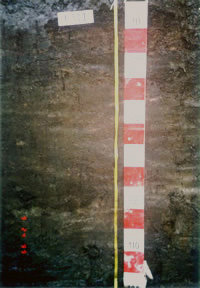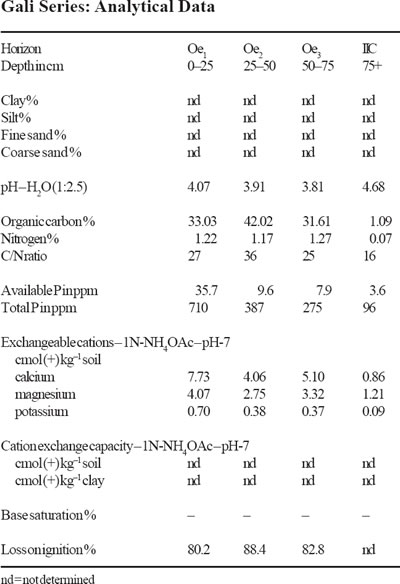Soil Profiles: Gali
Gali Series
The Gali Series is a member of the Gali Family which is a riverine-clayey, dysic Hemik (Terrik) Topogamborgs. It typifies this family and is autochthonous, low-ash, non-woody. These are shallow to moderately deep (50–150 cm) organic soils which are found in narrow valleys and inland swamps often in areas with sedimentary rocks. They have a high water table (unless artificially drained) and terric or hemic material form the dominant material in the subsurface tier. The underlying mineral soils in these organic soils occur at depths between 50 to 150 cm and consists of clay of riverine or colluvial origin. These soils have a low ash content and are dysic in the surface tier. The organic materials in these soils are generally non-woody.
Type Location
Soils of the Gali Series were first proposed and established during the Semi-Detailed Soil Survey of the Terengganu River Basin (Biot et al. 1982) but no description and analytical data were available in that report. The above pedon was described in the Rompin area of Pahang in a swamp forest. Location: Topographic Sheet 4456, 2°43’27” N, 103°32’12” E (Grid Reference 4456 – 155018 m).
Range in Characteristics
Little is known about the range in characteristics of the Gali Series. From what is known to-date the organic soil layer is dominantly hemic and non-woody and extends to a depth of 50 cm to 150 cm. The underlying mineral substratum is generally clayey (> 15% clay) and is alluvium/colluvium derived from sedimentary rocks. These soils can have a surface tier that is fibric, hemic and has a low ash content. Commonly the mineral soils are encountered below 75 cm depth.
Competing Soils and Their Differences
To-date a total of 18 soil series have been mapped as soils having shallow to moderately thick (50–150 cm) organic deposits. Of these only four soil series, namely the Bakri, Gali, Pak Bong and Tasik Series have hemic organic soil materials dominating the subsurface tier (50–100 cm). Both the Gali and Tasik Series are underlain by riverine/colluvial clays. Soils of the Gali Series are differentiated from the Tasik Series by the ash content in the surface tier. The Bakri Series has hemic materials in the subsurface tier but the underlying mineral material is marine-clayey and sulfidic.
Setting
Soils of the Gali Series are found in inland valleys or swamps found between hills of sedimentary rocks. Thus the underlying mineral soils are often clayey.
Principal Associated Soils
Little is known about the soils commonly associated with soils of the Gali Series. In the inland swamp situations these soils could be associated with other organic soils such as the Tasik, Pak Bong or Gadong Series. Where sedimentary rocks occur adjacent to the beach ridges these soils could occur close to the Igan, Mukah and Epai Series.
Drainage and Permeability
In their natural state soils of the Gali Series are permanently under water and are very poorly drained. When drained, shrinkage and decomposition of the organic materials takes place fairly rapidly. These soils may then no longer be classified as the Gali Series.
Use and Vegetation
In their natural state, soils of the Gali Series are mainly under sedges, grasses and shrub vegetation. Locally some of these areas have been drained and planted with vegetables.
Distribution and Extent
It is expected that soils of the Gali Series form small inland swamps in areas where sedimentary rocks form the hills. The actual distribution and extent is not known. To-date these soils have been mapped in Terengganu and locally in some other states.
Series Established
The Gali Series was first established in Terengganu, Peninsular Malaysia by Biot et al. (1982). It is not clear where the name was derived from.
Remarks on Classification
The Gali Series is classified here according to the Malaysian Soil Taxonomy – Second Approximation (Paramananthan 1998) as a member of the riverine- clayey, dysic family of Hemik (Terrik) Topogamborgs which is autochthonous, low ash, non-woody. They are classified as shallow to moderately deep (50–150 cm) organic soils in which hemic and terric materials dominate the subsurface tier (50–100 cm). The underlying mineral soil is riverine clayey (> 15% clay) and the organic layer is autochthonous and non-woody. The surface tier (0–50 cm) is both dysic and of low ash content. In the Keys to Soil Taxonomy – Eighth Edition (Soil Survey Staff 1998) this soil would be classified as Terric Haplohemists. In the FAO/UNESCO Soil Map of the World – Revised Legend (FAO 1990) this soil would probably be classified as Fibric Histosols.
Suitability for Agriculture
In their natural state, soils of the Gali Series are permanently under water and hence not suitable for agriculture. Once drained these soils can be used for the cultivation of vegetables, tapioca, sago and oil palm. However special management is required on these soils especially in relation to trace elements – copper, boron and zinc.



